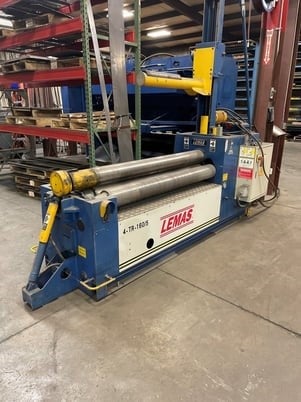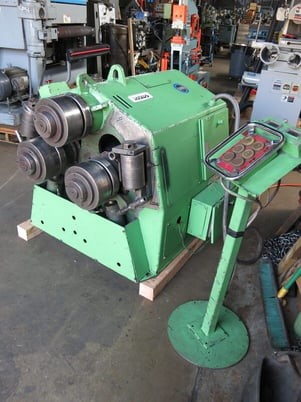Bending rolls, commonly known as plate or sheet rolling machines, are a type of equipment used to form predetermined bends in metal sheets or plates. The machine functions by passing the metalwork through sets of rolls, typically arranged in threes, that apply force to manipulate and create a desired curvature or bend.
These machines are indispensable in industries where metal sheets need to be shaped into cylindrical sections, tubes, or more complex curved surfaces. The versatility of this equipment makes it a staple in fabrication shops, manufacturing facilities, and any setting requiring the shaping of metal sheets or plates.


Popular Types of Bending Rolls
Bending rolls are essential tools in the metalworking field, used to shape metal sheets into various curved forms. Bending rolls come in various configurations including two-roll, three-roll, and four-roll designs, each offering distinct advantages based on the specific bending requirements, volume, and precision needed. The type of machine you choose depends on your project requirements, production volume, and the specific characteristics of the materials you’re working with. Here are some popular types of bending rolls:
- 2 Roll Machines: These machines are straightforward and typically used for large-radius bending. The simplicity of having just two rolls allows for easy operation and is particularly effective for producing long, large-diameter cylinders, and arches, commonly used in tank and pipe manufacturing.
- 3 Roll Initial Pinch: This variant involves a configuration where the top roll is stationary, and the two lower rolls move up to pinch and bend the material. It’s particularly useful for making tighter radii and is commonly employed in medium to heavy bending operations.
- 3 Roll Double Pinch: These machines are versatile, featuring two adjustable rolls (usually the bottom ones), allowing pre-bending at both ends of the material, reducing waste and handling. They’re used for medium to heavy bending tasks and can achieve tighter diameters.
- 3 Roll Variable Translating Geometry: Unique among bending rolls, these machines adjust the positioning of all three rolls, allowing for optimal flexibility and control in bending. They’re great for specialized tasks and can handle varying thicknesses and materials with precision.
- 4 Roll Double Pinch: These machines are known for their precision and ease of use, allowing pre-bending and bending in one pass, reducing handling and time. The inclusion of a fourth roll provides more control and makes them ideal for high-volume and high-precision applications.
- Vertical Rolls: Vertical rolls stand upright, which can save floor space and handle very wide or heavy materials, leveraging gravity to assist in the bending process. They’re commonly used in the construction and shipbuilding industries.
- Automated Cycle & Specialty Rolls: These high-tech rolls are designed for specialized and repeated tasks, often programmable for automated cycles, which increases production rates and consistency. They’re used in high-volume manufacturing environments or for specialized products requiring consistent replication.
2 Roll Machines vs 3 Roll Double Pinch vs 4 Roll Double Pinch
When choosing between 2 Roll Machines, 3 Roll Double Pinch, and 4 Roll Double Pinch bending rolls, understanding each type’s unique features, advantages, and potential drawbacks is crucial. Here’s a comparative analysis of these three popular types:
2 Roll Machines:
- Functionality: Primarily used for large-radius forming, 2 Roll Machines are simple in operation, involving just two rolls to produce curves.
- Advantages: Their simplicity makes them easy to operate and maintain. They are particularly suitable for creating large-diameter cylinders and arches with consistent curvature, and they require less manual repositioning of the metal sheet or plate.
- Limitations: They offer less precision for complex tasks or tighter radii and generally provide less control over the bending process compared to machines with more rolls.
3 Roll Double Pinch:
- Functionality: These machines have three rolls, with both lower rolls adjustable, allowing initial pre-bending on both ends of the metal sheet before rolling, thus reducing waste.
- Advantages: They provide more precision and control compared to 2 Roll Machines, especially for tighter radii. They’re versatile, suitable for medium to heavy bending tasks, and require less handling of the workpiece.
- Limitations: While they offer more control than 2 Roll Machines, they still involve more manual intervention and material handling compared to 4 Roll machines, especially in repositioning the sheet for pre-bending.
4 Roll Double Pinch:
- Functionality: These have the highest level of control among the three, with four rolls operating, allowing pre-bending and bending in a single pass and the capability of bending tighter radii.
- Advantages: They offer the highest precision and control, ideal for complex and high-volume tasks. The additional roll reduces material handling, increases efficiency, and enhances the consistency of the bends.
- Limitations: These machines are typically more expensive due to their complexity and might require skilled operators to leverage their full potential.
What to look for when buying Bending Rolls
Investing in the right bending roll requires careful consideration of various technical specifications to ensure it meets your operational needs and applications. Here are key factors to consider:
- Maximum Thickness of Coiled Plate (mm): Understand the maximum metal thickness the machine can handle. A higher capacity allows for versatility in operations but may come at a higher cost.
- Maximum Width of Coiled Plate (mm): Consider the maximum width of the material that the machine can bend to ensure it’s suitable for your projects.
- Plate Yield Limit (MPA): This indicates the maximum stress the metal plate can withstand while being bent. The machine should accommodate the strength characteristics of the materials you’ll be using.
- Rolling Speed (m/min): Higher rolling speeds contribute to increased production rates, but ensure it doesn’t compromise the quality of the bends.
- Minimum Diameter of Full Load Coil (mm): This refers to the smallest diameter the machine can coil a plate at full capacity. It’s essential for precision tasks requiring tight radii.
- Upper Shaft Diameter (mm) & Diameter of Lower Shaft (mm): The diameters of the shafts often relate to the machine’s load-bearing capacity. Larger diameters usually indicate an ability to handle heavier tasks.
- Center Distance Between Two Lower Axles (mm): This impacts the types of materials and the sizes that can be bent on the machine, influencing its versatility and applicability to different tasks.
- Main Motor Power (kW): A more powerful motor can provide greater bending force and handle tougher materials or thicker plates.
- Machine Weight (T) & Overall Dimension (L × W × H) (mm): Consider the machine’s footprint and weight, especially in relation to your available workshop space. Additionally, larger machines may require reinforced flooring.
Best practices for buying Bending Rolls
Purchasing the right bending roll is a significant investment that can greatly impact the efficiency and productivity of your operations. Here are some best practices to ensure you make an informed decision:
- Assess Your Needs: Start by clearly defining what you need the bending roll for. Consider the types of materials you’ll be working with, the size and thickness of the materials, and the complexity of the bending processes required. Your choice should match your most frequent applications.
- Prioritize Quality Over Cost: While budget constraints are real, prioritizing quality and reliability over upfront cost can save you money in the long term. High-quality machines require less maintenance, have longer service lives, and often come with better warranty conditions.
- Consider Future Requirements: Think about how your needs might evolve in the future. Investing in a machine with greater capacity and versatility might be more cost-effective in the long run, as it can adapt to more varied tasks and emerging needs.
- Verify Manufacturer Reputation: Research the manufacturers thoroughly. Look for companies with strong reputations in the industry, known for producing durable and efficient machines. Checking reviews and references can be very revealing.
- Request Demonstrations: If possible, ask for a live demonstration of the machine to see it in action. This allows you to assess its performance, ease of use, and whether it meets your specific operational needs.
- Understand Service and Warranty: Be clear on what the warranty covers and for how long. Also, understand the manufacturer’s service conditions, availability of spare parts, and whether they offer customer support and technical assistance.
- Evaluate Safety Features: The machine should comply with all relevant safety standards. Review the safety features in place to protect operators from potential hazards associated with the bending process.
- Consider the Total Cost of Ownership: Beyond the purchase price, consider all costs associated with the machine’s operation, including maintenance, parts, energy consumption, and manpower.
Advantages & disadvantages of Bending Rolls
Bending rolls, integral to metal fabrication, offer numerous benefits but also carry certain drawbacks. Understanding both sides is crucial for informed operation and purchasing decisions.
Advantages:
- Versatility: They can handle a wide range of materials and thicknesses, making them suitable for various applications across industries.
- Precision: Advanced models offer high precision, creating consistent, high-quality bends, essential for applications requiring tight tolerances.
- Efficiency: Bending rolls, especially those with more rolls, can significantly reduce production time by enabling pre-bending and bending in a single pass, crucial for high-volume operations.
- Reduced Labor Costs: Automated features reduce the need for manual intervention, leading to lower labor costs and human error.
Disadvantages:
- Cost: High-quality bending rolls, particularly those with advanced features or greater capacity, can require a significant initial investment.
- Space Requirements: They can be large, necessitating ample floor space, and might require additional logistics for installation and operation.
- Maintenance: Regular maintenance is necessary to ensure optimal functionality over time, which can incur additional costs and downtime.
- Training Needs: Skilled operators are required for more complex machines, necessitating training and experience.
Applications for Bending Rolls
Bending rolls are versatile pieces of equipment used across various industries due to their ability to form metal sheets into precise curved components. Here are several sectors where they find extensive application:
- Automobile Industry: Essential for shaping components like panels and bumpers, ensuring consistency and quality in vehicle assembly.
- Aviation: Critical in crafting precise structural elements of aircraft, handling materials common in aerospace with high accuracy.
- IT: Used in producing standardized server racks and computer casings, meeting the IT industry’s need for precision and consistency.
- Medical Treatment: Facilitates the creation of smooth, hygienic equipment components, such as bed frames and instrument panels, crucial for patient care environments.
- Energy: Integral in forming parts for diverse energy applications, from turbine components to solar panel frames and pipelines.
Accessories for Bending Rolls
Enhancing functionality and versatility, accessories for bending rolls are instrumental in optimizing operation and output quality. Here’s a brief look at some key accessories:
- Digital Readouts: Provide precise control over the bending process, offering clear, accurate measurements for consistent results.
- Cone Bending Devices: Enable the effective shaping of conical forms, expanding the machine’s capability beyond standard cylindrical shapes.
- Hardened Rolls: Especially useful for heavy-duty applications, these rolls resist wear and deformation, extending the machine’s operational life.
- Overhead Supports: Assist with the handling of large, heavy materials, making it easier and safer to feed them into the machine.
- Side and Top Supports: Offer additional stability for the workpiece during the bending process, improving precision and worker safety.
- Lubrication Systems: Ensure the machine’s moving parts are well-lubricated, reducing wear and maintenance needs while prolonging service life.
- CNC Controls: Facilitate automated operation, increasing efficiency, and consistency, especially for complex, repetitive tasks.
Tips & Tricks
You won’t have much difficulty finding a specific type of bending roll on Surplus Record. At the top of all the pages on our website, you’ll find a search bar. Type the phrase “bending roll” into it, click on the category that drops down, and review the options we have available.
We also work with a variety of dealers who specialize in bending rolls. Additionally, you can find dealers in your area or by name who specialize in bending rolls.

